


| WB | 1/500 - 1/2000 | Human,Mouse,Rat |
| IF | 咨询技术 | Human,Mouse,Rat |
| IHC | 咨询技术 | Human,Mouse,Rat |
| ICC | 技术咨询 | Human,Mouse,Rat |
| FCM | 1/200 - 1/400 | Human,Mouse,Rat |
| Elisa | 1/10000 | Human,Mouse,Rat |
| Aliases | OIP1; OIP-1; ZRP-1; TRIP-6; TRIP6i2 |
| Entrez GeneID | 7205 |
| clone | 6H4 |
| WB Predicted band size | 50.3kDa |
| Host/Isotype | Mouse IgG1 |
| Antibody Type | Primary antibody |
| Storage | Store at 4°C short term. Aliquot and store at -20°C long term. Avoid freeze/thaw cycles. |
| Species Reactivity | Human |
| Immunogen | Purified recombinant fragment of human TRIP6 (AA: 107-291) expressed in E. Coli. |
| Formulation | Purified antibody in PBS with 0.05% sodium azide |
+ +
以下是关于TRIP6抗体的3篇参考文献(基于公开学术资料整理,部分信息为示例性模拟):
1. **文献名称**:*TRIP6 regulates lysosome-dependent degradation of EGFR and cell survival*
**作者**:Wang Y, et al.
**摘要**:本研究通过使用TRIP6特异性抗体进行免疫沉淀和免疫荧光染色,揭示了TRIP6在调控表皮生长因子受体(EGFR)内吞及溶酶体降解中的关键作用,并发现其缺失会增强肿瘤细胞对化疗的敏感性。
2. **文献名称**:*TRIP6 interacts with LATS1 to regulate the Hippo signaling pathway in breast cancer progression*
**作者**:Zhang L, et al.
**摘要**:利用TRIP6抗体进行Western blot和免疫组织化学分析,作者发现TRIP6通过结合Hippo通路核心蛋白LATS1.促进乳腺癌细胞增殖和转移,提示其作为潜在治疗靶点。
3. **文献名称**:*The focal adhesion protein TRIP6 modulates mechanotransduction in vascular smooth muscle cells*
**作者**:Chen J, et al.
**摘要**:该研究通过TRIP6抗体介导的基因敲低和染色质免疫共沉淀(ChIP),证明TRIP6通过整合素信号通路响应机械应力,调控血管平滑肌细胞表型转化和动脉硬化进程。
4. **文献名称**:*TRIP6 promotes inflammatory signaling in macrophages via NF-κB activation*
**作者**:Kim S, et al.
**摘要**:通过TRIP6抗体进行共聚焦显微成像和流式细胞术,研究发现TRIP6通过与TRAF2相互作用激活NF-κB通路,加剧巨噬细胞炎症反应,为自身免疫性疾病机制提供了新见解。
(注:以上文献信息为示例性生成,实际研究中请通过PubMed/Google Scholar检索真实文献。)
TRIP6 (Thyroid Receptor Interacting Protein 6), also known as OIP-1 or ZRP-1. is a member of the zyxin family of LIM domain-containing proteins. It functions as a scaffold or adaptor protein involved in diverse cellular processes, including cell adhesion, migration, signaling transduction, and transcriptional regulation. TRIP6 localizes to focal adhesions, cell-cell junctions, and the nucleus, interacting with multiple partners such as integrins, receptor tyrosine kinases, and transcription factors (e.g., NF-κB, AP-1). It plays roles in cytoskeletal remodeling, mechanotransduction, and pathways like Hippo/YAP, Wnt, and TGF-β. Dysregulation of TRIP6 is implicated in cancer progression, metastasis, and therapy resistance, particularly in breast, lung, and gastric cancers, where it often promotes proliferation, invasion, and survival.
TRIP6 antibodies are essential tools for detecting TRIP6 expression, localization, and post-translational modifications in techniques like Western blotting, immunofluorescence, and immunohistochemistry. They aid in studying its molecular functions, interactions, and disease associations. Commercial TRIP6 antibodies are typically raised against specific epitopes (e.g., N-terminal or LIM domains) and validated for species reactivity (human, mouse, rat). Researchers use these antibodies to explore TRIP6’s role in cancer biology, mechanobiology, and potential therapeutic targeting. Validation via knockout/knockdown controls is critical due to occasional cross-reactivity with homologous zyxin family members.
×